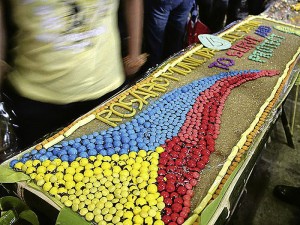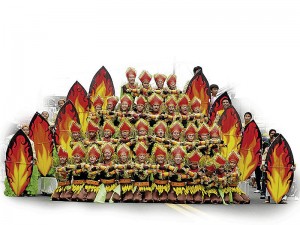
GASTRONOMIC DELIGHTS. Some 125 sinukmani displays were presented at the town's covered court during a contest. Photos by FEBBY MAE BARCELONA/contributor
ROSARIO, Batangas – A lowly delicacy known in the vernacular as sinukmani now comes off as a possible product for export. The potential is so huge that municipal officials here are looking into ways on how to package the delicacy for the overseas market.
Sinukmani is a popular Tagalog delicacy of glutinous rice cooked on coconut milk and sugar. Much like biko in appearance, the sinukmani of Rosario town is topped with caramel for added flavor. Some are garnished with local fruits for a more sophisticated appeal.
“Our residents are known to be long-time makers of the best sinukmani in the region, owing to the vast agricultural and farm lands that we have,” says Elizabeth Morpe, municipal administrator in an interview with the Philippine Daily Inquirer.
The Rosario town is touted one of the rice granaries of Batangas province boasting almost 28 hectares of land divided into 48 barangays. Agricultural production is the backbone of the municipality’s economy and its main products include rice, coconuts, mangoes, cocoa, citrus, bananas and avocado.
“Our sinukmani products are very viable and potent in boosting the local tourism,” says Morpe.
Best eaten during merienda, the sinukmani of Rosario is usually served on banana leaf and served with a cup of the world-famous kapeng barako. It is a favorite fare particularly during weddings because of its cultural significance. The sticky sinukmani embodies unity and strong, binding relationships for a married life.
Sinukmani Festival
Like in previous years, the delectable rice concoction took the spotlight last week in celebration of the town’s 394th founding anniversary. Despite heavy rains that came on the heels of typhoon “Dodong,” the aptly named Sinukmani Festival made the whole town festive in a weeklong celebration and thanksgiving.

STUDENTS of Sto. Nino Formation and Science School in Rosario, Batangas, show their mettle in a street dancing competition. Photo by FEBBY MAE BARCELONA/contributor
At the Luansing Plaza the townsfolk came in droves to have their share of the best-tasting sinukmani. Long tables were laid out with 125 sinukmani displays for a contest that was judged based on overall presentation and concept. Some were overly “nationalistic” with sinukmani festooned with colors of the Philippine flag. Special awards were given to the “Pinakamahabang Sinukmani” (Longest Sinukmani) and “Pinakamagandang Sinukmani” (Most Beautiful Sinukmani).
“More than anything else, we want our festival to be known in the region and other parts of the country similar to the Ati-atihan or Moriones,” adds Morpe.
While known for its world-class racing circuit – the Batangas Racing Circuit – the town still has to make noise in the region. Morpe says the locally produced sinukmani could help attract tourists and provide more jobs for the people.
To date the local trade office has explored ways into how to sustain the legacy of sinukmani makers which currently are “relatively few” in number. It has also tapped the help of a local maker in thinking ways on how to extend its shelf life for exports. Morpe says her office has also sought help of the people from the Department of Science and Technology.
Cooking sinukmani is no walk in the park. It requires hard work—and a lot of muscles to come up with a bilao of sinukmani. The more cooked the glutinous rice gets, the heavier it becomes.
For Helen Matibag of Barangay San Roque, “there is an art of cooking sinukmani” as it requires patience and the right timing. At 71-years-old, Lola Helen rarely accepts job orders and only cooks for special occasions. She helped make her barangay’s sinukmani display.
The Sinukmani Festival is already on its seventh year under incumbent Mayor Felipe Marquez administration.

